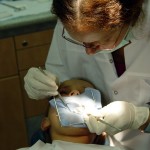
The microbial composition of infected primary teeth is similar to permanent teeth so should be managed in a similar way. Photodynamic therapy is an adjunctive approach thar uses a light source to excite a photosensitiser with the aim of inactivating microorganisms. A recent review (Pourhajibagher & Bahador, 2019 ) found that photodynamic therapy reduced microbial load in permanent teeth.
The aim of this review was to the efficacy of adjunctive photodynamic therapy (PDT) on root canal treatment in primary teeth.
Methods
A protocol was registered with the PROSPERO database. Searches were conducted in the Cochrane, Embase, PubMed, Scopus, and Web of Science databases. With no restrictions Randomised (RCTs) and non-randomised (nRCTs) clinical trials involving primary teeth were considered. Two reviewers independently selected studies extracted data and assessed risk of bias using the Cochrane’s risk of bias tool for randomized trials (ROB 2) and (ROBINS-I) tool for non-randomised studies. A narrative summary was provided due to study variation.
Results
- 4 studies (1 RCT, 3 nRCTs) involving a total of 72 patients were included.
- The RCT and two of the nRCTs were considered to be at low risk of bias.
- Patients ages ranged from 2-8 years of age.
- All included teeth had a diagnosis of necrotic pulp.
- 3 studies measured total viable bacteria in colony- forming units (CFUs) and one study CFUs of Candida Albicans.
- Phenothiazinium salts (methylene blue and toluidine blue O) were used as photosensitizer agents for PDT with concentrations varying across the studies.
- Only one study reported a statistically significant difference in microbiological load reduction with PDT.
Conclusions
The authors concluded: –
…moderate-to-low certainty of the available evidence was observed, and thus, no significant conclusions can be drawn from the findings.
Comments
Working with a pre-registered protocol the reviewers have searched a good range of databases. However only 4 small studies (sample sizes 10-32) met the inclusion criteria with none of the studies conducting a sample size calculation. The authors also point out that the photosensitizer agents received less than optimal irradiation time in all 4 studies and that microbiocidal load assessment methods used were considered to have low sensitivity and inability to detect certain species. The outcome of the included studies was change in microbial load when information on more clinically relevant outcomes such as tooth survival are needed. The 2018 Cochrane review on pulp treatment in primary teeth (Dental Elf – 8th Jun 2018) reported on outcomes at 12 and 24 months while only one of the studies in this review had data on 3 month follow up. As the authors note no conclusion on the role of adjunctive PDT can be drawn from this review. Future studies should be well designed conducted and reported using international best practice guidance using clinically relevant outcomes will follow up periods of 12 months or longer to improve the available evidence.
Links
Primary Paper
Araújo LP, Gobbo LB, Silva TAD, Rosa WLOD, Almeida JFA, Gomes BPFA, Ferraz CCR. Photodynamic therapy in the root canal treatment of primary teeth: A systematic review of clinical trials. Int J Paediatr Dent. 2023 May 17. doi: 10.1111/ipd.13088. Epub ahead of print. PMID: 37195228.
Other references
Pourhajibagher M, Bahador A. Adjunctive antimicrobial photodynamic therapy to conventional chemo-mechanical debridement of infected root canal systems: A systematic review and meta-analysis. Photodiagnosis Photodyn Ther. 2019 Jun;26:19-26. doi: 10.1016/j.pdpdt.2019.02.009. Epub 2019 Feb 10. PMID: 30753922.
Dental Elf – 11th May 2022
Pulpotomy in primary teeth- success of medicaments and techniques
Dental Elf – 8th Jun 2018
